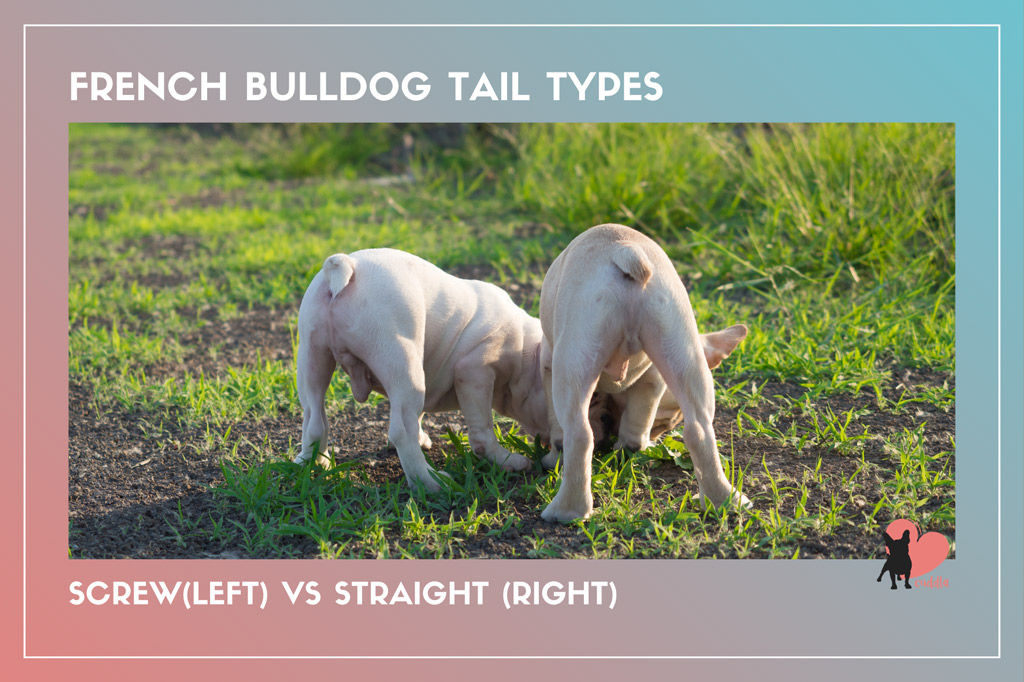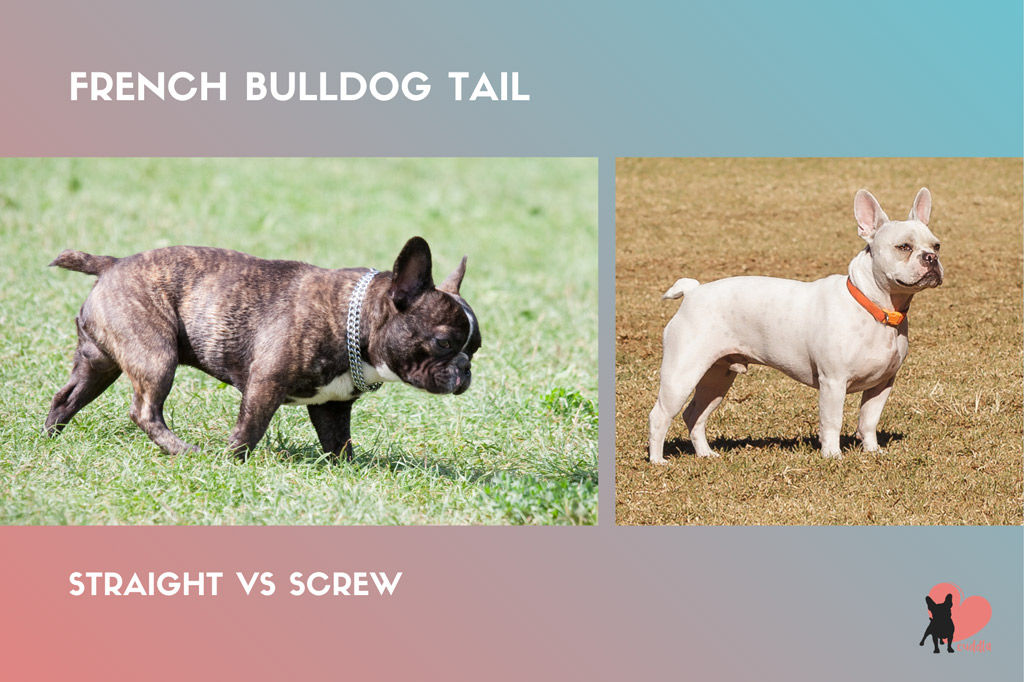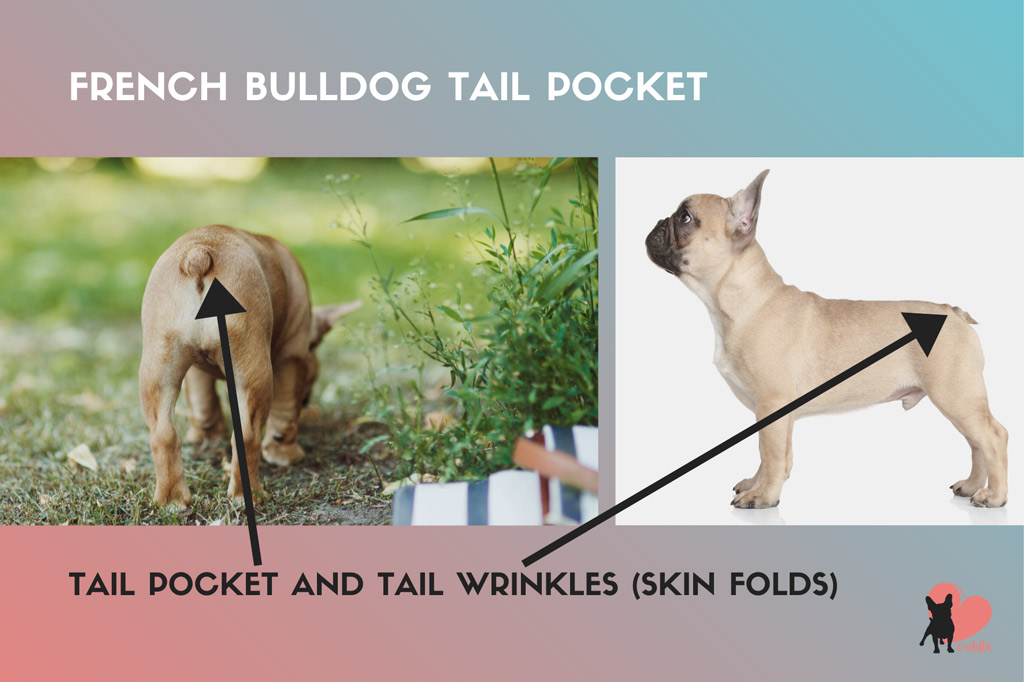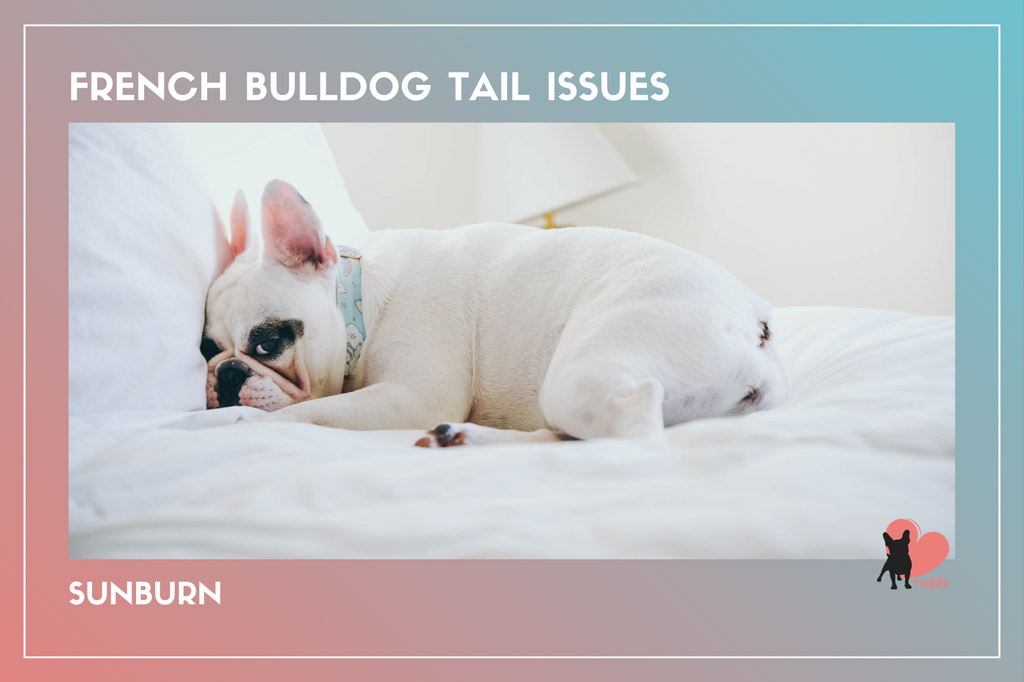
Depending on how familiar you are with the French Bulldog breed, the facts about their tails can be confusing:
Do they have tails at all? Are they docked?
These are very common questions.
Let’s have a look at Frenchie’s tail facts and types, the tail problems they can suffer from and how to clean their tail pocket.
French Bulldog Tail Facts
French Bulldogs, like Boston Terriers and English Bulldogs, generally have very short tails, which leads many people to think:
Does a French Bulldog Have a Tail?
According to the breed standards, French Bulldogs have a short tail that is thick at its root and fine at the tip.
Their tails hang low, i.e., they carry it on a low position.
French Bulldogs tail type can be either straight or screwed, but not curly (like Pugs or Boston Terriers).
More on types below.
Are French Bulldogs Born with Tails?
French Bulldog puppies are naturally born with very short tails. This feature is a part of the breed characteristics. One of their gene mutations causes the tail to grow unusually short.
It’s because of the Frenchies tinny tail (or the appearance of having a tail) that usually makes you wonder if this dog breed’s tail has been cropped.
So, the next question that you might be thinking is about docking practices.

Are French Bulldogs Tails Docked or Cut Off?
French Bulldog tails are not cut off or docked. Frenchies are born with short and stumpy tails due to their genes, not because they have been docked (i.e., someone has cut off a portion of the tail).
Tail docking is a harmful practice that isn’t (unfortunately) completely banned in some countries, like the U.K. Not only is it a painful procedure for your pooch, especially if not done at birth, but it also causes severe spine problems in the future.
There are no benefits to this practice, it’s an aesthetical choice. Also, tail docking disqualifies a dog from registration.

What Types of Tails Do French Bulldogs Have?
According to the breed standards, French Bulldog can have 2 types of tails:
#1 – A Straight Tail
The shape of the tail is straight and its longer than screw-shaped type.
The tail is set low on their rear, i.e., it points toward the ground when your dog is idle and calm.
#2 – A Screw Tail (Not Curly)
Screw tails are stumpy (short and thick). A French Bulldog’s screw tail is thick at its root and fine at the tip.
However, screw-shaped tails are not curly, i.e. French Bulldog’s tails are not curled like Pug’s tails are.

Can French Bulldogs Wag their Tails?
French Bulldogs cannot wag their tails because they are short, they wiggle their bottom instead, as a sign that they are happy.
Still, some Frenchies will manage to wag or shake their tail for a bit.
Insider Tip: French Bulldogs with straight and longer tails will tend to wag their tails more.

Do French Bulldogs Have Tail Pockets?
Another mystery is French Bulldogs’ tail pocket.
Both English and French Bulldogs are known to have a tail pocket. But not all Frenchies have a tail pocket. French Bulldogs with a straight tail don’t have a tail pocket.
However, French Bulldogs with a screw tail get a fold between their coat and where their tail sits, creating a fold, pocket or wrinkle.
Where Is the Tail Pocket on a French Bulldog?
The French Bulldog tail pocket refers to the area under their tail.
For some French Bulldogs, the tail pocket is more pronounced than for others.

French Bulldog Tail Problems
The most common health problems with French Bulldogs’ tails are infections, spinal deformities and sunburn:
#1 – Tail Pocket Infections
Screw tails can be a cause for infection.
When French Bulldogs have a screw tail, they are predisposed to tail infections, also known as tail pocket infections.
Because a tail pocket has hidden skin in the form of a wrinkle, it’s difficult to keep clean. That’s why it is susceptible to infections.
The skin folds or pocket in the base of the tail collects dirt and other substances and over time causes irritation. As a result of this, the tail can get infected.
Tail Infection Symptoms
The usual symptoms of tail infection are:
- Itching and redness in the area.
- Bad odour (due to the pus and dead skin).
Treatment for Tail Infection
Asses the severity and if you are unsure, check with your vet. However, you can start by cleaning the area:
- Wash the area with warm water and antiseptic soap first to remove any dirt.
- Then, you can use an antiseptic spray or wipes.
- After that, use a clean gauze to dry the area.
- You can also apply a soothing cream or coconut oil to help with the healing and reduce skin irritation.
Note: If you feel at any moment that the infection is getting worse, get in touch with your vet.
Preventing Tail Infections
Keeping your French Bulldog’s tail clean helps to avoid irritation and infections.
- Trim the hair around the tail regularly.
- Wash the tail wrinkles and pocket using dog grooming wipes (easy and effective).
- Apply coconut oil to prevent skin irritation, itchiness and dryness.

#2 – Tail Deformities: Hemivertebrae
Most canine vertebrae are shaped like cylinders, creating a flexible bony tube through which the spinal cord passes.
However, the vertebrae in a French Bulldogs’ tail are shaped like wedges or butterflies. Hemivertebrae refers to the bones in the spine that are abnormally shaped. This condition often leads to the tail being incorrectly aligned.
Screw tails are often the main cause of tail deformities and spinal issues due to the bones being twirled and crushing the spinal column and nerves.
As a result, French Bulldogs with screw tails can suffer from spinal deformities, also known as hemivertebrae condition.
Hemivertebrae Symptoms
Hemivertebrae in French bulldogs can be discovered by performing an X-ray and physical examination.
Symptoms include:
- Pain in the tail.
- Wobbliness and loss of hind leg function.
- In extreme cases, they can lose control of their bladder and bowels.
However, some Frenchies don’t have symptoms at all and are able to live a long happy life with their abnormally-shaped tail.
Treatment for Tail Deformities (Hemivertebrae)
In not so severe cases, treatment will usually consist of anti-inflammatory drugs.
But, more severe cases will require a surgical procedure called Hemilaminectomy in order to relieve the bones pressing on the spinal cord. This surgery can cost between $1500 – $4000.
This is an unexpected expense and is one of many scenarios where dog insurance comes in handy. With Petplan pet insurance, all hereditary and chronic conditions are covered as standard.
Preventing Tail Deformities
Unfortunately, the only way that hemivertebrae can be prevented is through responsible breeding.
When breeding dogs that have genetic malformities, we are putting another litter out there with a genetic predisposition to having these same problems. That’s why responsible breeding is so important.
Breeders can prevent future problems with French Bulldogs’s tails and bones by only mating:
- French Bulldogs that follow breed standards.
- A standard breed with a straight tailed breed (whether it’s long or short).

#3 – Sunburn
Finally, you might think this is weird – I certainly did, but French Bulldogs could get a sunburn if they get long exposure to direct sunlight.
Just like us, dogs are at risk of burning in the sun if they’re not protected, particularly those with short fine hair (like Frenchies) and pink skin (their bellies).
Not only do the soft membrane of their ears makes them vulnerable, but also their tails!
French Bulldog tails have little fur, that’s why this tender area makes them susceptible to sunburn.
Sunburns can be extremely uncomfortable, and harmful – your dog is vulnerable to skin cancer.
Sunburn Symptoms
Sunburn is also fairly easy to notice in your dog.
Common sunburn signs include:
- Red spots or pinkier colouring.
- Sore skin, i.e., skin sensitive to the touch.
- Peeling skin.
- Blisters.
If you notice that your Frenchie is severely sunburnt or blistered, call your vet.
Treatment for Sunburn
Your vet will examine your French Bulldog tail and skin to determine coat type and skin pigmentation.
Knowing how long your dog has been under the sun will also determine if your dog is sunburnt.
To treat a severe sunburn, heat exhaustion and dehydration, your dog will be provided with fluids. This helps to stabilize your Frenchie.
Cold compresses can be applied to your dog’s skin to relieve pain and cool the skin.
Your vet may also recommend a cortisone ointment to apply to the affected area and/or prescribe an antibiotic.
Preventing Sunburn
Here are some simple tips to prevent sunburn:
- Avoid sunbathing, especially if your dog loves roasting under the sun (very unlikely).
- Provide shade in the garden using a parasol or an elevated dog canopy, this limits your Frenchie’s exposure to direct sunlight.
- Avoid strong sun rays by keeping your dog indoors during peak hours of the day (midday). Only allow your Frenchie time in the sun early in the morning and during the late afternoon and evening.
- Discuss safe sun-screen options with your vet. The ASPCA says that ingesting certain sunscreens can cause drooling, vomiting, diarrhoea, excessive thirst and lethargy in pets. So, it’s best to read the label carefully and consult your vet when in doubt.
